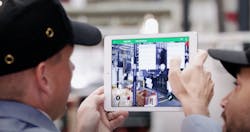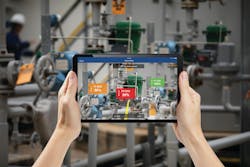In the world of manufacturing, augmented reality (AR) is one of those technologies that has been eagerly anticipated for years but isn’t yet widely used due to a lack of numerous commercial application examples. That’s starting to change as several forward-looking companies in the discrete manufacturing and processing sectors are publicly discussing their use of AR technology to decrease repair times, increase efficiency and safety, and seamlessly share knowledge across locations.
At Bühler Group, a $3.3 billion Swiss equipment manufacturer, plant floor operators use Schneider Electric’s EcoStruxure Augmented Operator Advisor (AOA) to access targeted information on handheld devices which is overlaid onto the actual equipment via the mobile device’s camera. AOA provides Bühler Group operators with access to real-time, asset-specific data including manuals, CAD drawings, safety information, and production checklists, greatly reducing human error and mean time to repair (MTTR). The ability to visualize everything from manuals to standard operating procedures (SOPs) to maintenance schedules and asset health information has enabled the company to dramatically reduce downtime.
According to Dr. Holger Feldhege, chief operating officer of manufacturing, logistics and supply chain at Bühler, the advantage of using AR to leverage Internet of Things (IoT) data lies in how it provides useful, targeted information to users where and when they need it—a huge improvement over the paper forms the company used to use.
On the market for about a year now, AOA has proven its viability at Schneider Electric’s own 500,000-square-foot Lexington, Ky., facility, where workers use the app to keep fabrication of its Square D Load Center line of products running. Preston Lockwood, maintenance manager at the Lexington facility, says the first step was to document all of the operators’ task lists and create videos that showed how to execute these tasks correctly. With those videos uploaded, implementation with AOA was fairly straightforward.
“All of my mechanics and technicians have tablets in house and they can access them through the AOA app,” Lockwood says. AOA shows them which preventive maintenance activities need to be performed, giving the technician the option of tapping to see a video or access a broad set of materials. With AOA providing support and backup, Lockwood finds it easier to schedule his staff of 30 technicians across three shifts.
“AOA gives me flexibility to put any resource I have on a task regardless of their specific knowledge. That helps avoid unplanned downtime and speeds correction of issues. That’s the biggest benefit,” he says.
Virtual visibility protects operators
Better safety is another win users are seeing from AR. When performing reactive maintenance and troubleshooting, it’s not always easy to pinpoint blocked sensors. “These machines are fairly big and there’s a lot of tooling and equipment moving around that gets in the way. You can’t necessarily see a sensor that gets blocked,” Lockwood says. If one station does not complete its cycle, all the other stations are kept waiting. Before using AOA, an operator would have to go back to an HMI to try to figure out what was going on, a process that might take several minutes if he could even find out what’s wrong using those technologies.
“AOA lets us see what the PLC is doing in real time. We can see the sensors, if they are being activated or not; we can see if the valves are being energized or not. I can have a technician pull up AOA and they can go through the overlays and see what is happening without having to lock out to find where the problem is,” he says. Previously, technicians would have had to open the gate and lock out the machine to see if the sensors were operating properly. Exposing all the automated equipment inside also poses an inherent risk, even if the machine is locked out.
Using AOA means the team doesn’t necessarily have to put up danger tape, don PPE (personal protective equipment), and clear out work areas to assess the situation effectively.
“AOA gives us much more information. We can go right to where the problem is. The less time we spend in the machine, the less risk to safety,” Lockwood says.
Of course, as with any new technology, there is a learning curve with AR, Lockwood says. Some people take it to it faster than others. Lockwood focused on little wins that helped drive overall buy-in. Now, he estimates AOA has helped the Lexington factory reduce MTTR by an impressive 20%—enough to get everyone’s attention and enthusiastic endorsement.
Pointing the way
Emerson Automation Solutions recently debuted its Plantweb Optics Augmented Reality, part of its Plantweb Optics platform, which is designed to help process manufacturers manage critical asset performance in the field.
One of the simplest and most powerful AR applications is to help the operator locate an asset and get directions to its position on the floor. This is especially helpful for contract workers or new workers trying to find a device, according to Vineesh Kapoor, product management director for Plantweb, Emerson Automation Solutions. “They can enter the name and the app will provide a route to that specific device with directions like ‘look down,’ ‘look up’ etc. This is very helpful in plants that have a lot of equipment,” Kapoor says. Instead of the worker having to climb a tower or a column on the hunt, the app helps pinpoint the exact location.
Thanks to integration with IoT devices in the plant, Plantweb Optics AR helps process companies make better decisions faster, Kapoor says. “Engineers can bring up the app on the tablet, see the equipment data, and make a decision without having to have any additional, unnecessary conversations.”
In the process industries, AR’s killer app is collaborations in the field. A technician can call a combined video and audio session depending on who is available to help with the problem. The expert can look over the technician’s shoulder virtually and provide advice on how to fix an asset, faster and safer than before.
One Emerson client, a food and beverage manufacturer, is preparing to use Plantweb Optics AR to help establish more efficient, consistent operations—a significant benefit for process operations where variability is the enemy of quality. The food and beverage manufacturer will store its procedures and documents in Plantweb Optics so they can be accessible in the field via the AR app. This helps ensure that technicians follow sanitation procedures. Historically, these procedures were kept in paper binders in the plant. Now they can be easily accessed by workers anywhere in the plant.
Engineers will also be able to quickly access step-by-step guides to numerous procedures. If troubleshooting is needed, the engineer can ask for help from a remote expert using Plantweb Optics AR. The expert can then walk them through the maintenance or repair procedure using printed instructions and annotations overlaid on the equipment via the AR app.
Kapoor says Emerson is “pleasantly surprised” about the pace of uptake on Plantweb Optics AR. In addition to the food and beverage company mentioned above, Emerson also counts a liquid natural gas customer and a life sciences company as early adopters.
Emerson Automation Solutions also offers an ROI calculator to help companies estimate the payback period of the AR tool and gauge how much money they might save by reducing the number of field trips. The quickest ROI comes in cases where there are lots of trips to the field, according to Kapoor.
“We see [an increase in field trips] occurring more and more as senior members of the operations organization retire. They know everything about the facilities and were able to do a lot,” Kapoor says. “We see many of our customers transitioning to outsourced maintenance to manage some assets, in addition to bringing in fresh talent from engineering or technical schools. The new people need time to learn about the equipment and how it is operated in the plant.” VR enhances the learning experience and also tends to make it more compelling for learners.
And if AR can help those organizations cut a trip to the field, that’s a lot of hours saved. For example, take a small work order in a chemical plant. Assuming no expert help is required, that work order might typically take four hours to finish, requiring the engineer to get out the binder containing the SOP, walk over to the asset, inspect it, go through the steps in the work order, check the work, and then close out the work order. Now, the technician can call up the Plantweb Optics AR app and move through the steps much more quickly, saving at least three hours. “These are the kinds of cases where you are seeing a huge benefit from AR,” Kapoor says.
Leaders relevant to this article:



